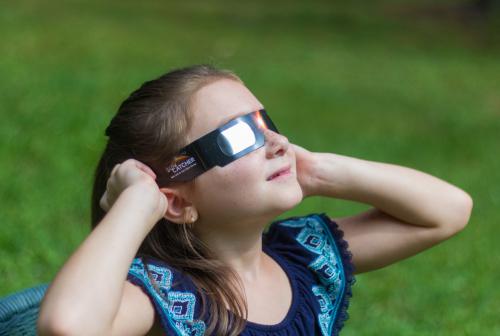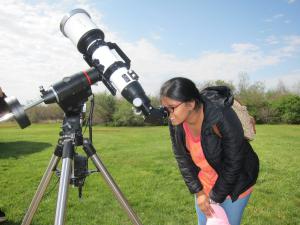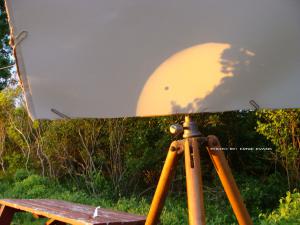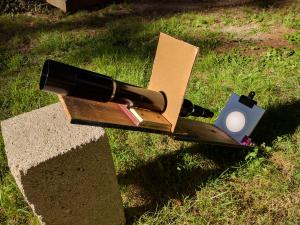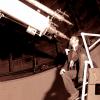Safely Observe The Solar Eclipse
In the United States, solar eclipses do not happen as frequently as they do around the world, and Americans get super hyped about the prospect of viewing the Moon pass in front of the Sun. Though viewing a solar eclipse will be quite memorable, safety is paramount to forming a lasting positive memory, instead of a lasting vision impairment.
Depending on what type of solar eclipse you are observing, safety requirements change slightly. There are no times during a partial eclipse or annular eclipse where you can safely observe without adequate eye protection. If you are along the Path of Totality and experience a total solar eclipse, you can safely observe the eclipse without eye protection only during the short total eclipse period. Though outside of that time, you must wear adequate eye protection.
Adequate eye protection will substantially reduce the amount of sunlight passed into your eye. The most common device for safely observing a solar eclipse directly are ISO 12312-2:2015 certified Eclipse Glasses. These devices are usually made of paper and have extremely dark flexible plastic lenses. There are many distributors selling non-certified eclipse glasses and deceivingly labeling them as certified. As such, the American Astronomical Society (AAS) has published a list of reputable manufacturers and vendors that are selling legitimate, safe eclipse glasses. Additionally, #14 welders glass will offer you a safe alternative to view the eclipse and the Sun. Note that any old welders glass is not adequate, it must be #14 welders glass.
If watching the eclipse via Eclipse Glasses is just not geek enough for you and you are looking to step up your game, then observing the eclipse with a telescope is the ultimate geek out! Though you significantly increase your chances of SEVERE eye damage when using a telescope. If using a telescope, you will need to either have a Hydrogen Alpha telescope or a small telescope securely fitted with a White Light filter. NEVER look through a telescope pointed at the Sun with a filter over the eyepiece alone, this is dangerous!! Filtering mechanisms must always be located at the aperture end (side that is pointed at the sky) of a telescope or optical device. Note that many people will have telescopes setup to observe the event. Be wary about casually walking up to somebody's telescope and taking a look. We have seen many setups with terribly unsafe filtering elements!
If you have a set of binoculars, they can be setup to project the Sun onto a wall or other surface. To do this, you would setup your binoculars on a tripod, have your binoculars pointed at the Sun and have the image of the Sun shine out of the back of the binoculars onto a surface. When doing this, at no time should you ever look through the binoculars, not during setup, alignment, or projections. If you are unfamiliar with this method, then I would recommend against doing it as it also introduces a fire hazard. Think about lighting matches with a magnifying glass and the Sun, fire hazard.
If all of these options are not available to you, you can safely observe the eclipse indirectly using a camera obscura device. Such devices will project the eclipse onto another surface through a small opening. You can make a camera obscura out of a cardboard box. You can punch a hole into an index card and project the Sun onto a surface. Slightly open your outstreched fingers and place them over the slightly open and outstreched fingers of your other hand while placing your back to the Sun. Look at the shadow your hands cast, tiny eclipses will be in between the shadows of your fingers. Step under a tree and look at the shadow of the leaves on the ground. The light in between leaf shadows will be in the shape of eclipses.
At Frosty Drew Observatory we have numerous safe viewing options available for visitors. Telescopes with adequate filtering mechanisms are available, solar projectors will be setup, a camera will be in a telescope projecting live views onto monitors and screens setup around our campus, Eclipse Glasses will be available for use and we will have stations where you can make camera obscura devices.
If you have your own solar telescope, or own a filtering device for binoculars or a telescope, please do not bring it to Frosty Drew Observatory for any solar viewing event. Only authorized viewing devices will be permitted at Frosty Drew solar viewing events. Authorized viewing devices that are acceptable to bring are:
- ISO 12312-2:2015 certified Eclipse Glasses
- #14 welders glass
- Camera obscura devices
- An official Sunspotter
- Contained safe solar projectors (subject to inspection by Frosty Drew astronomers)
Unauthorized viewing devices that will not be permitted at Frosty Drew solar viewing events are:
- Solar telescopes of any kind
- Binoculars either filtered or unfiltered
- Any sunglasses that are not ISO 12312-2:2015 certified
- Any other viewing device not previously listed as authorized
At Frosty Drew Observatory we are geared up and ready to go for fantastic events with the Sun. Be aware of the dangers, put forth a little caution, and there is no reason why you can’t have a fabulous eclipse viewing experience and walk away knowing your eyes and vision are safe and secure for another day’s viewing. So get out and enjoy a safe, science experience with the Sun.
- Author:
- Scott MacNeill
- Entry Date:
- Mar 30, 2024
- Published Under:
- Scott MacNeill's Columns

